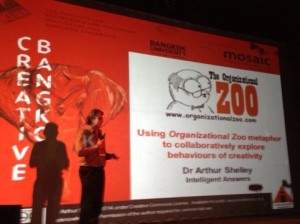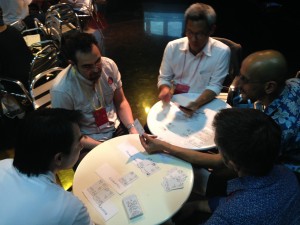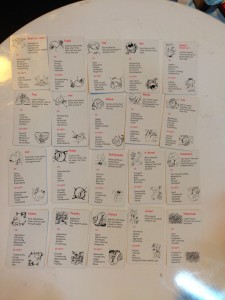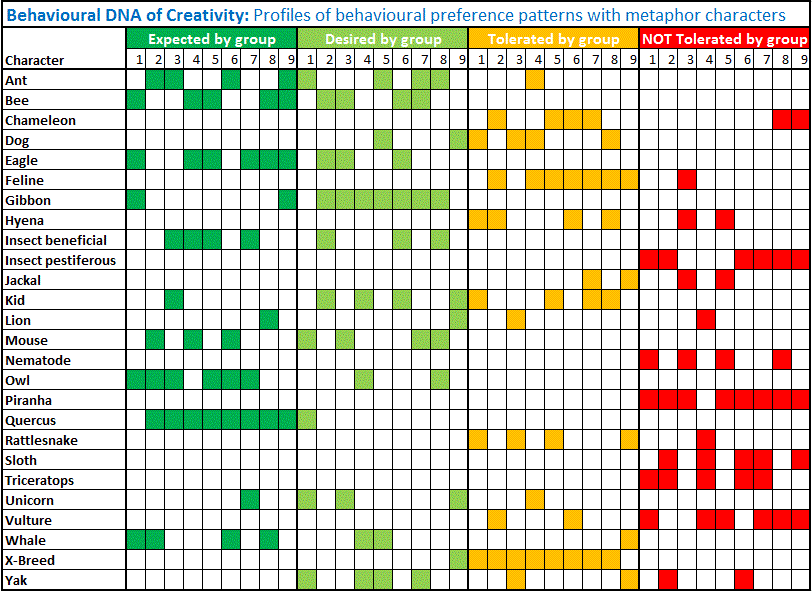The participants of Creative Bangkok 2014 engaged in assessing what “animals” (Organizational Zoo metaphor characters representing behaviours) supported creativity and which were detrimental to it. After a very quick introduction (because we wanted intuitive interpretation and creative open exchange of perspectives with minimal preconception) to The Organizational Zoo, participants allocated character cards into 4 categories fo r the context of generating creative environment:
r the context of generating creative environment:
Expected (required for creative outcomes)
Desired (not absolutely required, but a positive influence on creativity)
Tolerated (not desirable, prefer not to be displayed)
Not Tolerated (will have a strong disruptive impact on creativity)
Five characters were selected for each category, which left six characters out, as being less relevant to the question (not better or worse, just not as applicable to this context).
Nine groups of 4 or 5 people were given just 20 minutes to sort the cards. Then participants walked around to observe other groups’ outputs and discuss similarities and differences. A high level analysis of the overall patterns of selection is in the table below and a graphical representation of this will be published soon. Note, there are 26 Organizational Zoo characters, each representing behavioural stereotype found in organisations.
| Selection outcome | SelectedCharacters | Names of characters selected Likely collective impact of this grouping on environment, based characters’ salient properties. |
| All groups selected as positive (Expected or Desired) |
4/26 = (15%) | Bee, Eagle, Gibbon, Quercus Collaborative teamwork with inspirational leadership and a fun, trusted and philanthropic environment. |
| Most groups selected as positive (none selected negative) | 3/26 = (12%) | Insect (beneficial), Mouse, Owl Cross-pollinating ideas sharing, with mentoring/nurturing approach and productive task completion orientation. |
| Mainly positive perceptions with some negative |
3/26 = (12%) | Ant, Unicorn, Whale Productivity that can be slightly off mainstream or idealistic, whilst incorporating intelligent technology. |
| Balance of positive and negative perceptions | 4/26 = (15%) | Dog, Kid, Lion, Yak Loyalty, naivety with some control and command/process with enthusiasm (even if a little prone to errors). |
| Mainly negative perceptions with some positive |
2/26 = (12%) | Vulture, Xbreed Propensity to criticise others and some arrogance about cleverness or value of own ideas. |
| Most groups selected as negative (none selected positive) | 10/26 = (38%) | Chameleon, Feline, Hyena, Insect (pestiferous), Jackal, Nematode, Piranha, Rattlesnake, Sloth, Triceratops. Predominated by political and silo-group interests rather the open sharing with all. High level of aggression and competition or change resistant disengagement. |
| All groups selected as negative(Tolerated or Not Tolerated) | 0/26 | None |
 A very quick commentary on this is shared here, with the intent to share a much deeper and wider analysis in a longer article in the future. It is clear there are definite patterns in what people DO like for creativity, there is a much wider spread in what they think disrupts it. No two groups generated the same output and yet participants’ could see the logic of each answer in facilitated conversations about the selections. This highlights the inherent diversity of perspectives amongst the individuals and groups involved and the value in exchanging these views. The discussions in selecting which character went where was lively and engaging at all tables and despite differences of opinion the atmosphere was fun. A useful insight is that three of the four characters selected by ALL groups, were also selected (in another activity with different people in a different country) by all groups when asked to characterise optimal leadership (Eagle, Bee and Quercus). It is not surprising that in this environment and the creative way the whole conference was led, the Gibbon also emerged as essential for creativity (thanks largely to Vincent Ribiere!). Interestingly, in that other activity, there was also more diversity of opinion around disruptors than for stimulants of the right environment.
A very quick commentary on this is shared here, with the intent to share a much deeper and wider analysis in a longer article in the future. It is clear there are definite patterns in what people DO like for creativity, there is a much wider spread in what they think disrupts it. No two groups generated the same output and yet participants’ could see the logic of each answer in facilitated conversations about the selections. This highlights the inherent diversity of perspectives amongst the individuals and groups involved and the value in exchanging these views. The discussions in selecting which character went where was lively and engaging at all tables and despite differences of opinion the atmosphere was fun. A useful insight is that three of the four characters selected by ALL groups, were also selected (in another activity with different people in a different country) by all groups when asked to characterise optimal leadership (Eagle, Bee and Quercus). It is not surprising that in this environment and the creative way the whole conference was led, the Gibbon also emerged as essential for creativity (thanks largely to Vincent Ribiere!). Interestingly, in that other activity, there was also more diversity of opinion around disruptors than for stimulants of the right environment.
This just represents a small part of my own interpretation of the results (based on the collective results across 45 participants). There is no doubt that the greatest insights and outcomes will emerge from discussing these with others. A key to learning and professional development is to challenge oneself with new ideas and others’ perspectives and explore the possibilities and options that emerge. Although you may not agree with everything you exchange, you get more possibilities to reflect upon and this helps you to see outside “your box”. That is, challenge your own entrenched patterns of thought and decision-making to evolve your capabilities, by adopting or adapting things you did not know about.
As Theodore Zeldin stated: “The kind of conversation I like is one in which you are prepared to emerge a slightly different person.”
Are you inclined to act in lion mode and tell or open yourself to seek the ideas of others through gibbon, owl, eagle and bee?
What is worth highlighting is that the interactions in the room were vibrant and constructive. The Organizational Zoo metaphor cards are a fun and creative way to stimulate dialogue around the impacts of behaviour on creativity amongst a diverse and international group. When conversations about behaviour are actively facilitated in an open and trusted environment, they generate positive outcomes. If the environment is not conducive to inclusive engagement of different perspectives, the outcomes are limited (or even disengaging for those involved and undermining trust and or intended outcomes).
There is no doubt that this interaction brought about insights for those involved and helped to build connections and stronger relationships. Continuing to stimulate conversations like this amongst your teams and stakeholders over time, will assist you to achieve a creative environment and deliver higher performance. This approach can also be used to facilitate in difficult conversations. That is, enable challenging behavioural aspects of a situation that would otherwise not be openly talked about! This represents a real benefit, as being able to proactively and constructively discuss such matters, is far better than leaving them to the corrosive corridor conversations that ultimately damage everyone.
It is important to acknowledge that the final outputs (tangible results) of such activities are less important than the outcomes and interactions between the people involved. It can be seen that there is a variety in what behaviours people like, and don’t like, when creatively interacting. The key is not the result, but in understanding what others appreciate or dislike, so that you can interact better with them. Assume what they like, or that they are just like you, is less effective than engaging in a quick fun activity that brings you closer to understanding each other. It can even highlight differences in perspective that you can each leverage value from.
Better we understand and leverage these differences than go into conflict over them.
The image below shows all selection for all groups.




 Creative Commons License
© Arthur Shelley 2013 - 2024
Creative Commons License
© Arthur Shelley 2013 - 2024
No comments yet.